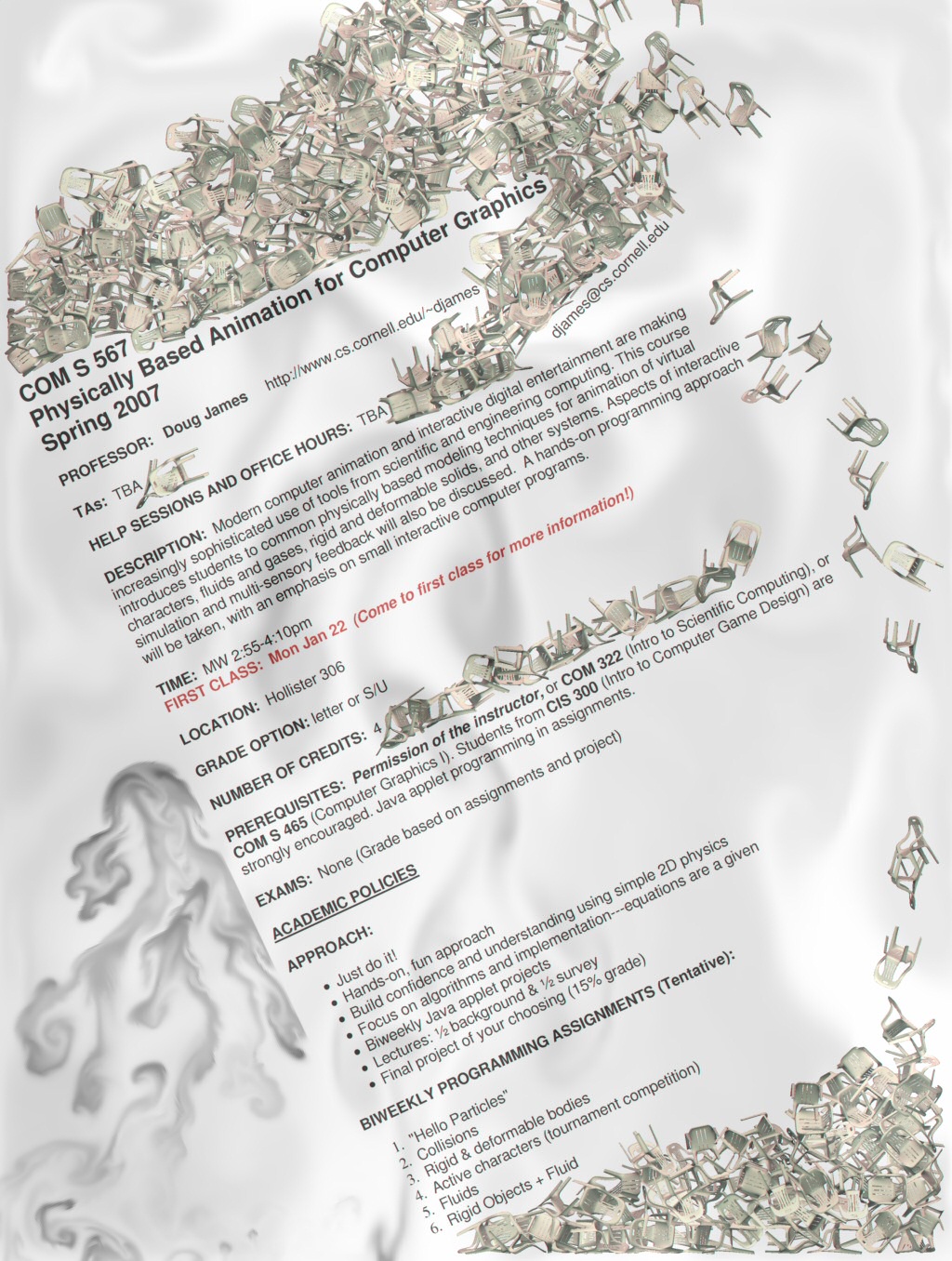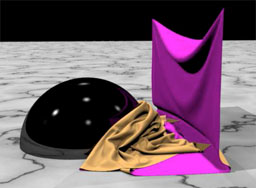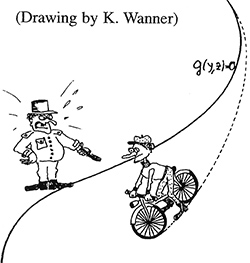DATE
|
TOPIC
|
SUPPLEMENTAL MATERIALS
|
TuSep26
|
Introduction
|
Slides (PDF)
Readings:
|
ThSep28
|
Particle Systems
|
Material:
- Particle dynamics
- Energy-based modeling
of forces
- Numerical integration
References:
|
ThSep28
TuOct03
ThOct05
|
Robust Collision Processing
|
Material:
- Collision detection basics (broad/narrow phases)
- Velocity-level collision resolution
- Continuous collision detection
- 2D (point-edge, sphere-sphere), and 3D
(point-face, edge-edge) tests
- Impulse resolution; restitution coefficient
- Supporting pin/trajectory constraints
- Inverse-mass-matrix filtering
- Penalty forces
- Rigid cloth zones
References:
- Cloth related:
- Robert Bridson, Ronald P. Fedkiw, John Anderson, Robust Treatment of
Collisions, Contact, and Friction for Cloth
Animation, ACM Transactions on
Graphics, 21(3), July 2002, pp. 594-603
- A. Selle, J. Su, G. Irving, and R. Fedkiw, Robust
High-Resolution Cloth Using Parallelism,
History-Based Collisions and Accurate Friction, IEEE
Transactions on Visualization and Graphics (TVCG),
15(2), 339-350.
- Robust Treatment of Simultaneous
Collisions, David Harmon, Etienne Vouga, Rasmus
Tamstorf, Eitan Grinspun, ACM Transactions on
Graphics, 27(3), August 2008, pp. 23:1-23:4. (equality-constraint
alternative to rigid cloth zones)
- X. Provot, Collision and self-collision handling
in cloth model dedicated to design garment. Graphics
Interface, 1997. (first introduction
of rigid cloth zones)
- General collision
detection:
- M.
Lin and S. Gottschalk, Collision
detection between geometric models: A
survey, Proc. of IMA
Conference on Mathematics of Surfaces,
volume 1, pp. 602-608, 1998.
- P.
Jimenez, F. Thomas, and C. Torras, 3D collision
detection: A survey,
Computers & Graphics, Elsevier, 25(2),
pp. 269-285, 2001.
- Gino
Van Den Bergen, Efficient
collision detection of complex deformable
models using AABB trees, Journal of
Graphics Tools, 1998
|
|
Assignment #1:
Robust Collision Processing
(a.k.a.
"The Spaghetti Factory (Take 2)")
|
Starter Code
available on Canvas. |
TuOct10
TuOct17
|
Constrained Dynamics
|
Material:
- Holonomic constraints,
C(p)=0.
- Example: Bead on a wire
- Differentiating
constraints w.r.t. time.
- Constraint Jacobian, J
- Lagrange multipliers,
lambda, and constraint forces, J^T lambda
- Solving for Lagrange
multipliers
- (Implicit constraint
(and half-explicit) DAE integration schemes)
- Post-step projection
schemes
- Position- vs
velocity-based corrections
- Applications:
Mechanical linkages, inextensibility constraints,
incompressible flow, contact constraints
References:
- David Baraff and Andrew
Witkin, Physically Based
Modeling, Online
SIGGRAPH 2001 Course Notes, 2001.
- Examples from Cloth
Simulation:
- Rony Goldenthal,
David Harmon, Raanan Fattal, Michel Bercovier,
Eitan Grinspun, Efficient
Simulation of Inextensible Cloth, ACM Transactions on
Graphics, 26(3), July 2007,
pp. 49:1-49:7. [ACM Digital Library link]
- Jonathan
M. Kaldor, Doug L. James,
Steve Marschner, Simulating Knitted
Cloth at the Yarn Level, ACM Transactions on
Graphics, 27(3), August 2008,
pp. 65:1-65:9.
[Advanced] References for
Differential-Algebraic Equations (DAEs):
|
ThOct12
|
Taking Derivatives:
From Tensor Calculus, to
Symbolic and Automatic Differentiation
|
Material: Differentiating
the following quantities with respect to particle
position vectors, p_i:
- constant, c
- position, p_j
- vectors, (p_j-p_k)
- distances, ||p_j-p_k||
- distance powers, ||p_j-p_k||^n
- functions of distance, W(||p_j-p_k||)
- dot products, (p_1-p_0)^T (p_3-p_2)
- cross products
- Example: hair bending energy derivative, E =
k*sin^2(theta/2) [handout]
[Mathematica]
Other topics:
Reference:
|
ThOct12
ThOct19
TuOct24
|
Rigid-Body Dynamics
|
References:
- David
Baraff and Andrew Witkin, Physically Based
Modeling, Online
SIGGRAPH 2001 Course Notes, 2001.
- Two-body impulse calculation: See
Baraff course notes.
- Excellent
recent review:
- Related topics:
- Rigid damping
- Rigid cloth zones
|
|
Assignment #2:
Constrained Dynamics
|
- Starter Code: Use your code
from Assignment #1.
- Relevant 2016 written
assignment on inextensibility constraints (handout,
solution)
|
TuOct24
|
Final Project Proposal
|
|
ThOct26
TuOct31
ThNov02
TuNov07
|
Fluid Animation
|
Topics:
- Navier-Stokes
equations; Euler equations for inviscid fluids
- Advection;
semi-Lagrangian methods
- Splitting
schemes
- Incompressibility
constraint & divergence-free flow
- Helmholtz-Hodge
decompositions; pressure projection
- PIC/FLIP
methods [Zhu & Bridson 2005]
- APIC
method [Jiang et al. 2015]
Materials:
- Bridson,
R. and Muller-Fischer, M. 2007. Fluid Simulation for
Computer Animation: SIGGRAPH 2007 Course Notes,
In ACM SIGGRAPH 2007 Courses. [Slides, Notes]
(main reference for class)
- Jos
Stam, Stable Fluids,
Proceedings of SIGGRAPH 99, Computer Graphics
Proceedings, Annual Conference Series, August 1999,
pp. 121-128. [Slides
and notes]
- Ronald
Fedkiw, Jos Stam, Henrik Wann Jensen, Visual Simulation of
Smoke, Proceedings of ACM SIGGRAPH
2001, Computer Graphics Proceedings, Annual
Conference Series, August 2001, pp. 15-22.
(introduces vorticity confinement forces)
- C. Jiang,
C. Schroeder, A. Selle, J. Teran, A. Stomakhin, An
Affine Particle-In-Cell Method, ACM
Transactions on Graphics (SIGGRAPH 2015), 34(4), pp.
51:1-51:10, 2015. [PDF]
- Y. Zhu and
R. Bridson, Animating sand as a fluid, ACM SIGGRAPH
2005. [PDF]
[MOV]
(introduced PIC/FLIP to graphics)
|
|
Assignment #3: APIC
Fluid Simulation
|
|
ThNov09
|
Application
of Rigid-Body Motion:
Shape Matching Methods
|
Discussed:
- Projecting
particle motion to be rigid motion
- Rigid-body shape
matching
- Fast Lattice Shape
Matching (FastLSM)
- Other methods
(adaptive FastLSM; oriented particles)
Material:
- Matthias
Müller, Bruno Heidelberger, Matthias Teschner,
Markus Gross, Meshless deformations
based on shape matching, ACM Transactions
on Graphics, 24(3), August 2005, pp. 471-478. [ACM] [PDF] [AVI]
- Alec R.
Rivers, Doug L. James, FastLSM: Fast Lattice
Shape Matching for Robust Real-Time Deformation,
ACM Transactions on Graphics, 26(3), July 2007, pp.
82:1-82:6. [ACM] [PDF]
- Denis
Steinemann, Miguel A. Otaduy, Markus Gross, Fast Adaptive Shape
Matching Deformations, ACM
SIGGRAPH/Eurographics Symposium on Computer
Animation, Dublin, July 7-9, 2008. [PDF] [AVI]
- Matthias
Müller and Nuttapong Chentanez. Solid
simulation with oriented particles. ACM
Trans. Graph. 30, 4, Article 92 (July 2011), 10
pages, 2011. [ACM]
[PDF]
[MOVIE]
|
TuNov14
ThNov16
|
Rigid-body Contact:
Impulse- and Contraint-based Methods:
|
Material:
- General
discussion of rigid-body contact principles (contact
constraints & impulses, restitution, Coulomb
friction, maximal dissipation principle,
Signorini-Fichera condition, connection with
constrained optimization & KKT conditions,
etc.), and methods such as impulse-based [Guendelman
et al. 2003] and constraint-based [Erleben et al.
2007; Kaufman et al. 2008] solvers.
- Impulse-based
contact solvers:
- Brian Mirtich,
John Canny, Impulse-based
Simulation of Rigid Bodies, 1995
Symposium on Interactive 3D Graphics, April 1995, pp. 181-188.
- Eran Guendelman, Robert Bridson,
Ronald P. Fedkiw, Nonconvex Rigid
Bodies With Stacking, ACM
Transactions on Graphics, 22(3), July 2003, pp.
871-878. [an iterative impulse-based solver]
- Projected Gauss-Seidel solver:
- K.
Erleben, Stable, robust, and
versatile multibody dynamics animation. Ph.D.
thesis, Department of Computer Science, University
of Copenhagen, Denmark, 2005. [avi movie]
- K.
Erleben, Velocity-based
shock propagation for multibody dynamics
animation, ACM Trans. Graph. 26, 2,
Jun. 2007.
- Projected
Jacobi solver:
- SIAM
Review of rigid-body contact:
- Excellent
recent review:
- "Staggered Projections" method:
- A good reference on convex
optimization:
- Stephen
Boyd and Lieven Vandenberghe, Convex Optimization,
Cambridge University Press, 2004.
- Stanford
lecture notes/book [PDF]
|
TuNov28
|
Particle-based Fluids
![GPU-accelerated SPH [Harada et al.
2007]](http://www.cs.cornell.edu/courses/cs5643/2015sp/images/thumb_HaradaGPUSPH.jpg)
![OpenVDB [Museth; Dreamworks Animation]](images/thumb_museth.jpg) |
Material:
- Smoothed Particle Hydrodynamics (SPH)
- Matthias Müller, David
Charypar, Markus Gross, Particle-based
fluid simulation for interactive applications, 2003
ACM SIGGRAPH / Eurographics Symposium on Computer
Animation (SCA 2003), August 2003, pp. 154-159. [Video]
- Miles
Macklin and Matthias Müller. Position
Based Fluids. ACM Trans. Graph. 32, 4,
Article 104 (July 2013), 12 pages. (other
videos)
- Liu, G. Gui-Rong, and M. B. Liu. Smoothed
particle hydrodynamics: a meshfree particle
method. World
Scientific, 2003.
- Wikipedia
- Takahiro Harada, Seiichi Koshizuka, Yoichiro
Kawaguchi, Smoothed Particle
Hydrodynamics on GPUs, Computer Graphics
International, pp. 63-70, 2007.
- B. Solenthaler, R. Pajarola, Predictive-Corrective
Incompressible SPH, ACM
Transactions on Graphics, 28(3), July 2009, pp. 40:1-40:6. [PDF]
[YouTube
Video]
- SIGGRAPH fluids course: [SPH
pages (pp.
83-86)]
- Bridson, R., Fedkiw, R., and Muller-Fischer, M.
2006. Fluid simulation:
SIGGRAPH 2006 course notes, In ACM
SIGGRAPH 2006 Courses (Boston, Massachusetts, July
30 - August 03, 2006). SIGGRAPH '06. ACM Press, New
York, NY, 1-87. [Slides, Notes]
- Robert
Bridson, Fluid Simulation for
Computer Graphics, A K Peters, 2008. [Book
format]
- Coupling SPH and rigid-body simulations (advanced):
- N. Akinci, M. Ihmsen, G. Akinci, B. Solenthaler,
M. Teschner, Versatile Rigid-Fluid
Coupling for Incompressible SPH, ACM
Trans. Graph. (SIGGRAPH Proc.), 2012. [PDF]
[AVI]
- Isosurface extraction + rendering
|
ThNov30
|
Animation Sound
|
Material:
- K. van den Doel
and D. K. Pai, The
Sounds of Physical Shapes, Presence:
Teleoperators and Virtual Environments, 7:4, The MIT
Press, 1998. pp. 382--395.
- Kees van den
Doel, Paul G. Kry, Dinesh K. Pai, FoleyAutomatic:
Physically-Based Sound Effects for Interactive
Simulation and Animation, Proceedings of ACM
SIGGRAPH 2001, Computer Graphics Proceedings, Annual
Conference Series, August 2001, pp. 537-544. [Video]
- Dinesh K. Pai,
Kees van den Doel, Doug L. James, Jochen Lang, John
E. Lloyd, Joshua L. Richmond, Som H. Yau, Scanning
Physical Interaction Behavior of 3D Objects,
Proceedings of ACM SIGGRAPH 2001, Computer Graphics
Proceedings, Annual Conference Series, August 2001,
pp. 87-96. [Video]
- James F.
O'Brien, Perry R. Cook, Georg Essl, Synthesizing
Sounds From Physically Based Motion,
Proceedings of ACM SIGGRAPH 2001, Computer Graphics
Proceedings, Annual Conference Series, August 2001,
pp. 529-536.
- Perry R.
Cook, Sound
Production and Modeling, IEEE Computer
Graphics & Applications, 22(4), July-August
2002, pp. 23-27.
- James F.
O'Brien, Chen Shen, and Christine M. Gatchalian. Synthesizing
sounds from rigid-body simulations. In The
ACM SIGGRAPH 2002 Symposium on Computer Animation,
pages 175–181. ACM Press, July 2002.
- Yoshinori
Dobashi, Tsuyoshi Yamamoto, Tomoyuki Nishita, Real-Time
Rendering of Aerodynamic Sound Using Sound
Textures Based on Computational Fluid Dynamics,
ACM Transactions on Graphics, 22(3), July 2003, pp.
732-740. [project
page]
- Doug L. James,
Jernej Barbić and Dinesh K. Pai, Precomputed
Acoustic Transfer: Output-sensitive, accurate
sound generation for geometrically complex
vibration sources, ACM Transactions on
Graphics, 25(3), pp. 987-995, July 2006, pp.
987-995.
- Changxi Zheng
and Doug L. James, Harmonic
Fluids, ACM Transaction on Graphics (SIGGRAPH
2009), 28(3), August 2009, pp. 37:1-37:12.
- Jeffrey
Chadwick, Steven An, and Doug L. James, Harmonic
Shells: A Practical Nonlinear Sound Model for
Near-Rigid Thin Shells, ACM Transactions on
Graphics (SIGGRAPH ASIA Conference Proceedings),
28(5), December 2009, pp. 119:1-119:10.
- Changxi Zheng
and Doug L. James, Rigid-Body
Fracture Sound with Precomputed Soundbanks,
ACM Transactions on Graphics (SIGGRAPH 2010), 29(3),
July 2010, pp. 69:1-69:13.
- Jeffrey
Chadwick and Doug L.
James, Animating
Fire with Sound, ACM Transactions on Graphics, 30(4), August 2011.
- Jeffrey
N. Chadwick, Changxi
Zheng and Doug L.
James, Precomputed
Acceleration Noise for Improved Rigid-Body Sound, ACM Transactions on Graphics, August 2012.
- Steven S.
An , Doug L.
James, and Steve
Marschner, Motion-driven Concatenative
Synthesis of Cloth Sounds, ACM Transactions on Graphics, August 2012.
- Timothy
R. Langlois and
Doug L. James, Inverse-Foley
Animation: Synchronizing rigid-body motions to
sound, ACM Transactions on Graphics
(SIGGRAPH 2014), 33(4), August 2014.
|
TuDec05
|
Guest Speaker
|
Guest
Speaker:
Title:
- "Just Enough Non-Linearity"
BONUS:
- LUNCH: Attend the student lunch (noon-1pm) with Ted in Gates 392 to hear more about life at Pixar, etc.
|
ThDec07
|
Project Presentations
|
|
|
|
|
|
|
|
|
|
|
![Monsters Inc. [Pixar]](images/pixar_8999674.jpg)
![Yarn-level cloth simulation
[Yuksel et al. 2012]](images/thumb_StitchMeshes_teacozy.jpg)
![[Langlois and
James 2016]](images/thumb_Langlois2016.png)
![From [Bai et al. 2016]](images/thumb_Bai2016.png)
![Monsters Inc. [Pixar]](images/pixar_8999674.jpg)
![Yarn-level cloth simulation
[Yuksel et al. 2012]](images/thumb_StitchMeshes_teacozy.jpg)
![[Langlois and
James 2016]](images/thumb_Langlois2016.png)
![From [Bai et al. 2016]](images/thumb_Bai2016.png)





![Rigid Body Dynamics (from [Baraff
2001])](images/thumb_RBD.png)

![From [Stam 1999]](images/thumb_stableFluids.png)
![Pengchinko! [Rivers and James 2007]](images/thumb_fastlsmPenguins.jpg)
![From [Erleben]](images/thumb_erleben.png)
![From [Kaufman et al. 2008]](images/card.png)
![GPU-accelerated SPH [Harada et al.
2007]](http://www.cs.cornell.edu/courses/cs5643/2015sp/images/thumb_HaradaGPUSPH.jpg)
![OpenVDB [Museth; Dreamworks Animation]](images/thumb_museth.jpg)

![[Baraff and Witkin 1998]](images/thumb_BW98.jpg)
![From Nucleus [Stam
2009]](images/thumb_pub_nucleus.jpg)
![From [Muller et al. 2006]](images/thumb_posBasedDyn.jpg)
![Fracture sound -- From [Chadwick et al. 2012]](images/thumb_fasterPAN_SCA2012.jpg)
![From "Power
Particles" [de Goes et al. 2015]](images/thumb_pp.jpg)

![from [Kim et al. 2008]](http://www.cs.cornell.edu/%7Edjames/research/pics/Kim08.png)